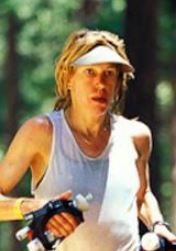

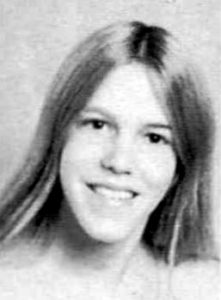

In 1981, when Trason was 20 years old, she attempted her first ultra and ran the American River 50 Mile, a combined road/trail course. It did not go well; lacking experience and knowledge how to fuel and push for that distance, she dropped early from the race, and thought to herself ultra-distances were not for her. Four years later, in 1985, she again ran American River 50, in hot temperatures, and this time won and set the women’s course record (7:09:01) for her first ultra finish. She returned and lowered the record two years later to 6:23. When she finished rewriting the event’s record book eight years later, she had lowered her mark by another whole hour. Her 6:09:08 course record remains untouched today, nearly 30 years later.
Trason’s competitive focus ultimately centered on the singe event with which her career is most associated — the Western States 100 miler, on familiar trails in the California Sierra. She started the race in 1987 but did not finish due to a knee issue. She again ran in 1988 but dropped because of dehydration problems. She thought she was through with the mountain 100s, but a friend talked her into trying the Leadville 100 miler in Colorado. There, she put it all together, the talent, the training, and the temperament that it took to win in 1988.
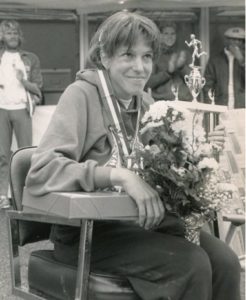

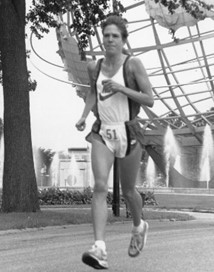

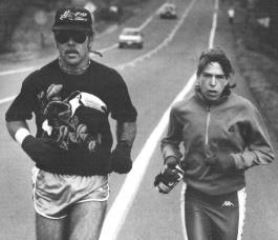

Only one month later, in a performance that signaled her amazing powers of recovery from world-class efforts (which would be put on display in spectacular form in subsequent years), Trason won the U.S. National 100 km Championship at the Edmund Fitzgerald Ultra in Duluth, Minnesota, missing her own world record by only three minutes. In 1990, the “Ed Fitz” hosted the second IAU World 100 km Championship, where Trason, the defending world champion, had to settle for silver, losing to the legendary Eleanor Adams of Great Britain in cold, windy conditions.
Ultrarunning Magazine’s editor Stan Wagon wrote of her remarkable splash into ultrarunning, “No other woman has excelled at such a high level on such different courses: Leadville’s altitude, Western States’ heat and hills, the asphalt of a one-mile loop in New York City, and a sloshy 400-meter track.”
As the 1990s began, Trason was a woman on a mission, igniting the sport. Trason’s performances early in her career set the bar for women ultrarunners to aim high. In terms of legacy, that is perhaps her greatest accomplishment, a total paradigm shift in women’s ultra-endurance athletics. In 1991, she again went to New York and ran at the 1991 Sri Chinmoy 100-mile race on the flat, paved, roads of Flushing Meadows Corona Park in Queens, New York. There, she met legendary Ted Corbitt for the first time and went on be the overall winner again, setting multiple world records including a final time of 13:47:41 for 100 miles.
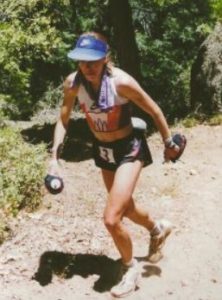

Trason won Leadville three more times, most memorably when she raced against the Tarahumara tribesmen in 1994, just four weeks after her record run at Western States. She led the race late but succumbed to intestinal distress, finishing runner-up overall with 18:06:24; the only American in the top five. Her time remains the women’s course record to this day. She dominated mountain 100-milers, and in 1998 completed the Grand Slam (four summer classic 100-milers) in a cumulative time of 79:23:21, not only the women’s record, but faster to date than all but seven men.
Trason’s 1988 100K world record had been broken by Birgit Lennartz of Germany, and she wanted it back. 100K road races were the rage in Europe in those early years after the IAU established its world championship. In 1993, Trason picked a competitive race in Amiens, France, where many of the world elites would be running. She blew away the women’s field with a new world record of 7:09:44. Two years later she would improve that standard. At the 1995 IAU World Championship in Winschoten, Netherlands, Trason led the American women to the Team Gold and she ran to yet another world record of 7:00:48. It was a breakout moment on the world stage for Americans: the cumulative team time of 22:28:20 by Trason, Donna Perkins, and Chrissy Duryeawould stand as the team championship record for a dozen years, and remains the #2 all-time team mark to date. Trason’s own time, while later broken at world level twice by two Japanese runners, remains the American Record a quarter-century later.
What stage remained for Trason to claim as her own? The world’s largest and oldest ultra and one of the oldest races on the planet, the Comrades Marathon in South Africa, approximately 55 miles of road between Durban and Pietermaritzburg, alternating directions each year. It was the sport’s biggest world stage, in a nation that regarded the race as its Boston Marathon. Hundreds of thousands of people cheered each year along the course. Trason was finally well-known, bore a target on her back, but in 1996, she became the first American woman to ever win the famed race. She did so with an uphill course record of 6:13:23. Not one to leave a job half-done, she returned in 1997 to run the downhill edition and won again with 5:58:25, still the second all-time “down” mark for this event that has been run for nearly a century.
Trason went into apparent retirement in 2004. She later discovered that she had an undiagnosed ACL tear and had been running on it painfully for the past ten years, so she focused on her health and recovery and avoided the spotlight. In 2013, at age 53, she surprised many when she returned to ultrarunning and ran a few 100s. It was no longer about racing and winning, it was about enjoying running in the mountains. She loved motivating and helping others. She said, “Don’t let anyone else say you can’t do something. The worst thing in life is not to try. I’d rather have failure than to not have tried at all.” Once she could no longer truly run because of her knees, she walked and finished many loop road events with determination. A new generation of ultrarunners, were able to share the ultra experience with a trailblazing pioneer and modern-day legend.
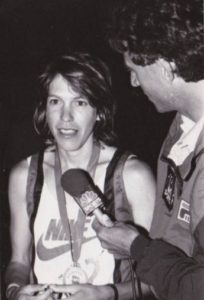

Congratulations to Ann Trason. Visit the American Ultrarunning Hall of Fame to read about the past inductees.
